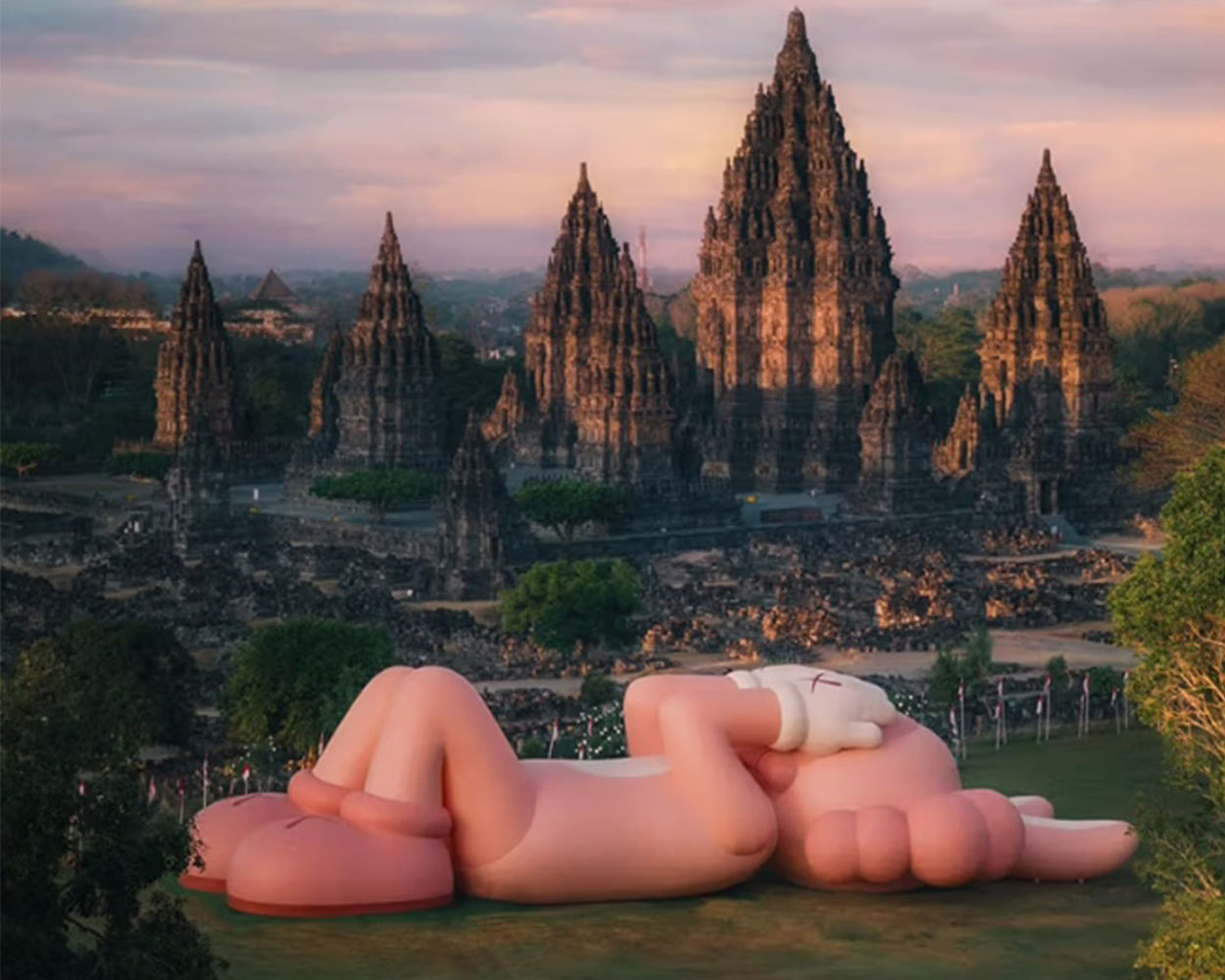
With summer usually packed with international music festivals, blockbuster weekends at the cinema and yacht trips along the Mediterranean coast, art can often take a back seat in the news. We thus have to tip our hats to New York based Brian Donnelly, better known by his professional alias, Kaws, for making headlines with his 45 metre-long pink cartoon rabbit sculpture erected on the grounds of a 9th century Hindu temple complex in Indonesia
The exhibit marks the 10th stop on the KAWS: Holiday world tour — a series of larger-than-life exhibits across the past six years featuring giant versions of his sculptures “lazing” on the grounds of popular public spaces worldwide, save for a 2020 iteration which saw Kaws’ “Companion” figurine rocketed 41km into the stratosphere by balloon for a two-hour zero-gravity walk before gently falling back down to Earth via parachute.
Reimagining Public Spaces
The KAWS: Holiday series is in collaboration with Hong Kong based creative studio, AllRightsReserved, and challenges our notions of where and what art can be. Kaws’ fans know that he does not take himself too seriously, just as with his alias which he claims was a random sequence of letters he felt sounded pleasant together. Kaws was previously reported saying that he wishes for the KAWS: Holiday series to be something that can not only be easily enjoyed by the public but also assimilate into the existing cultural landscape of its chosen setting rather than take away from it.
The choice of showcasing giant sculptures in public spaces are significant in the dialogue on what constitutes our experiences of public spaces. These giant sculptures are impossible to hide from sight, showing up even on satellite images. This inevitable contending with what the sculptures are transforms passive, taken-for-granted sites into interactive and immersive spaces rich for new discourse on how to experience the sites themselves.
This is especially salient for cultural sites like the Prambanan temples of Yogyakarta. Yogyakarta remains today a special region of Indonesia still under a monarchy, owing to its historical significance as what some consider the birthplace of Javanese civilisation as well as its custodianship over Javanese fine art and culture. Prambanan continues to attract visitors from all over as a UNESCO World Heritage Site, making it a fruitful site for reimagining contemporary and ancient art side by side, each informing new readings of one another. The exhibit is also Kaws’ first time debuting his “Accomplice” figure as a giant sculpture, standing as his largest sculpture to date.
The Kaws Controversy: Contemporary or Commercial Artist?
Yet, many in the art world continue to be unsettled by the status Kaws enjoys in pop culture. Kaws is often criticised for teetering on the edge between contemporary and commercial art. “Accomplice” itself was initially intended for commercial release in 2002 as a vinyl figure collectible, sales for which will be sure to enjoy a surge with the impending social media coverage on the Prambanan exhibit.

This perhaps an inevitable impression to form of Kaws who intentionally packages and advertises his art as mass-produced collectibles as a commentary on neoliberal consumerism and the ubiquitousness of pop culture imagery, drawing inspiration from the Pop Art movement of the 50s to the 60s. Nevertheless, one cannot deny how Kaws has risked assimilating into pop culture rather than disrupting it, with his collectibles becoming so sought after that they have themselves transformed into mere pop culture images to be replicated and distributed in the form of toys, clothing, etc.
Apart from extending his audience reach to different parts of the globe, the KAWS: Holiday series also marks a milestone for Kaws’ career as an artist. No longer just l’art pour l’art, Kaws’ status in pop culture has already preceded his art itself, such that most people recognise his works as commercial Kaws products rather than works of art.
For Better or Worse?
Hate or love Kaws, the KAWS: Holiday series undeniably manages to achieve what most artists today only hope to — turning heads and making people think. To ask the questions of “What does this mean?” and “Is this art?”. Criticisms of selling out aside, Kaws is still one of the few artists today that have helped bridge the realms of commercial and fine art, allowing for greater accessibility to art for all.
- READ MORE: BODHI’s First Stand-Alone Exhibition at Gallery 1819 is a One-Of-A-Kind Visual Experience
In opening his art works in such public spaces, Kaws flips the traditional model of appreciating art, forcing art into our consciousness rather than eaving it in the museum to wait for visitors. In Kaws’ world of surrealist landscapes and cartoon giants, art jumps out of the painting and comes to us instead. The Prambanan Exhibit proves to be exciting for fans, especially after legal disputes over intellectual property rights halted the last KAWS: Holiday stop in Singapore temporarily.
The exhibit will be on view from 19 to 31 August. Will you be visiting the giant “Accomplice” in Yogyakarta this summer?
This article originally appeared on Luxuo.
